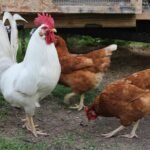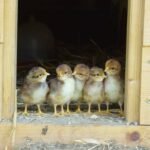Everything You Need to Know About Rabbit House and Housing Systems

Building good rabbit housing for your rabbits is a basic requirement for success in rabbitry farming.
As a result, you must ensure that the rabbit house you build is conducive enough for the animal.
Rabbits, just like other animals cannot tell you about their problems and needs in their housing.
Therefore, you have to construct the rabbit cages to meet certain requirements.
This article is for those who keep rabbits as pets and those into commercial rabbit farming.
In this post, I will guide you through the fundamentals of a proper rabbit housing construction.
You will get to see the different types of rabbit hutches alongside their pros and cons.
I will end the article by mentioning some good materials for constructing good rabbit housing.
To get started, let’s get to the details of what a rabbit housing is then we look at some of the basic requirements of a proper rabbit house.
What is Rabbit housing?
A rabbit housing refers to proper cages or hutches and arrangement for feeding, watering, and caring for rabbits.
Rabbit houses are important to keep the rabbit in one roof and to prevent them from running away.
In the wild, rabbits live in groups, and the best-known species, the European rabbit, lives in burrows, or rabbit holes.
A group of burrows is called a warren.
For domesticated rabbits, they live in hutches and cages with a run.
Every rabbit is different, however, from experience, it generally takes around 6 months for a bunny to finally feel settled and happy in their new home.
Where can I keep my domestic rabbits?
There are several ways of housing rabbits.
Domestic rabbits can be raised outdoors or indoors.
Housing for rabbits ranges from outdoor hutches to indoor cages, to the free run of the home.
Whichever option is most suitable for your home and rabbit, all should provide a shelter from extreme weather conditions and predators as well as a resting place for the rabbits.
What are the materials for constructing a rabbit house?
There are several materials for building a conducive house for rabbits.
Your choice of materials depends on your financial budget as well as the climate of the place.
In backyard rabbit farming, you can use locally available materials.
Some of the commonly used materials include tin cans, bamboos, old boxes, wood, bricks, asbestos sheets, wire meshes etc.
Basic features of proper rabbit housing
To ensure that your rabbits enjoy their stay on your farm, then the housing should meet certain standards.
So, I will just go ahead and list out some of the requirements that ensures adequate housing for rabbits.
- The rabbit housing must allow for proper ventilation and free airflow
- Also, you must have functional cooling, heating and lighting systems. Most likely, your focus will be on heating systems because rabbits barely tolerate extremely cold temperatures.
- In below-zero climates, supplemental heat may necessary for sustained rabbit production.
- Use insulated roofs to make the rabbit house so that it can protect against excessively hot and cold weather conditions.
- The roofs should also be adequate enough to hold rainwater from sipping through.
- Ensure entrance plenty of fresh air without any draft. This is because a draft may cause colds and cause the rabbits to come down with pneumonia.
- If possible make proper use of natural shade and prevent excessive winds.
- Moving forward, make a fence around the house area to keep the rabbit free from predators like snakes, cats etc.
- Always group the rabbits according to their age because they often fight with each other and injure themselves. Sometimes they kill or injure the younger rabbits.
- Ensure you make a drain inside the house for easy collection of urine and
- Open all the vents during the summer season and close them partially in the winter season.
- Use small adjustable centre ridge ventilation and it will help to escape excessive moisture from the house.
- If you would, then a fan-type air controlling system is recommended for commercial rabbit housing. In this regard, you will need to contact an expert to help you with the specifications and installation.
Types of rabbit housing for commercial farming
There are three different types of rabbit housing for commercial rabbit farming, they include; standing hutches, stacked cages, and suspended cages with barn cover.
1. Standing Hutches

The standing rabbit hutch is a common type of rabbit housing among beginner farmers.
It is also ideal for testing out the rabbit market in an area because it can only house a fewer number of rabbits.
Before you invest all your capital into the rabbit business, you can use this type of housing for a pilot project.
Standing hutches for rabbits have the advantage of being relatively low cost to build.
Also, it is ideal for small production especially when you don’t have huge capital.
You can customize smaller units of the hutch with wheels to make it portable and easy to move.
The downside of this system is that it is difficult to scale because of the small space it occupies.
2. Stacked Cages

This system involves stacking series of cages on another.
The stacked rabbit cage system is ideal for commercial rabbit farming.
You can use this rabbit housing type both indoors and outside as long as it is well ventilated and allows free airflow.
The upside of this rabbit housing system is that it allows for larger rabbit production.
Because the hutches are stacked, you can house more rabbits using less floor space.
Also, the fact that this system is done in a controlled area facilitates the rapid growth of your business.
On the downside, this stacked cage system tend to be more costly to purchase/make.
Also, indoor production requires airflow (with air-conditioners) and extraction units involving extra cost.
In addition, it can be very costly to maintain and requires a greater amount of cleaning.
3. Suspended Cages with Barn Cover

This is the most common type of rabbit housing for larger commercial rabbit productions.
In this type of rabbit housing system, the rabbit cages hang down from the ceiling or the corners of the wall.
This arrangement makes it to clean, lowers the cost of maintenance, and makes for easy expansion.
The only downside is that the rabbits are more vulnerable to the elements than with an inside production.
But you can still control environmental elements like cold weather and wind using a trampoline.
Alternatively, you can make a solid wall in the windward and backside of the rabbit house.
Basic guidelines for using rabbit cages for farming
There are different types of cages which you can use for rabbit farming.
However, the design of the cages may vary according to your taste and the breed which you want to raise.
If it is possible for you, try to use metal cages for your rabbit housing.
Metal cages make it easy to maintain proper hygiene in the rabbitry thereby prevent health problems.
- Use a 1 x 2-inch mesh for the top and sides of the rabbit cage while the floor should be made of 0.5 x 1-inch mesh.
- Every single rabbit cage should be at least 30 inches deep, 20 inches high and 30 inches wide. This measurement may differ depending on the rabbit breed and size.
- In single layers, the cages hanging from the ceiling is very easy to manage for the farmer. So, you should consider using the suspended cages.
- You may keep non-breeding does, angora, small does and castrated bucks in one house in a small group.
- However, you must keep every adult does and bucks in individual cages.
- Ensure that a feed trough and watering system is attached to every rabbit cage.
- Also, provide some straws and fresh hays in the cages of does during their delivery time and winter season.
- Finally, ensure that you provide adequate lighting in the rabbit housing. Light is a very essential element for rabbits. Moderate light management helps the rabbit to grow well and it is very essential for their breeding. Always use 12 hours of lighting and 12 hours darkness period to keep them productive and breeding well.
Guidelines for maintaining proper hygiene in a rabbit housing
In every kind of livestock farming including rabbit farming, proper sanitation is very important.
Maintaining proper hygiene in rabbit housing helps to prevent infections and the spread of diseases.
To ensure proper hygiene and sanitation, keep to the following guidelines;
- Make pits below the cages and cover with layers of gravel, drainage tile or sand for easy removal of waste.
- You could also use concrete floors, but it will require you to clean the floor frequently.
- Keep concrete walkways between the cages for easy removal of accumulated manure.
- Ensure you clean the manure at least once in every month.
- Clean and sanitize the cages after every use.
- Use a propane gas burner to burn the hairs that attach to the cages.
- If you bring in new rabbits, make sure to keep them separate, because they may be infected by a disease that can affect your rabbits.
In conclusion
Depending on the size of your rabbit farming business, you can make plans and arrange adequate budget for your rabbit housing.
You can choose from the three types of rabbit housing which are; the standing hutches, the stacked cages and the suspended cages.
Any type of cage you end up using will still be perfect as long as you maintain proper hygiene and follow other necessary guidelines.
If you need more help with your rabbit farming business, then you can go ahead and ask your questions below.
Do not forget to share this article with someone. Click on the social media icons on this page to share this post now.
Cheers.
- 12 Best Chicken breeds for Eggs – chicken breeds for eggs

- When Do Chickens Start Laying Eggs Regularly?

- How Many Eggs Does A Chicken Lay In A Week?

- Fermenting chicken feed – The definitive guide

- 10 Sure Ways To Stop Chickens from Eating Their Eggs [+Bonus]

- 6 Best Chicken Egg Incubators for Chicken Eggs and Other Birds

- 10 Common Chicken Sounds and (How to Understand Them)

- How to Get Rid of Bad Chicken Manure Smell

- How to Make Simple DIY Chicken Nesting Boxes







This is an informative and comprehensive guide on rabbit housing systems, providing valuable insights for those interested in raising rabbits or starting their own small-scale farming business.
Thanks ♥️😻😘🎆🎆🎇✨✨🎇🎉🏅🎖🥇
You are welcome, Joy.